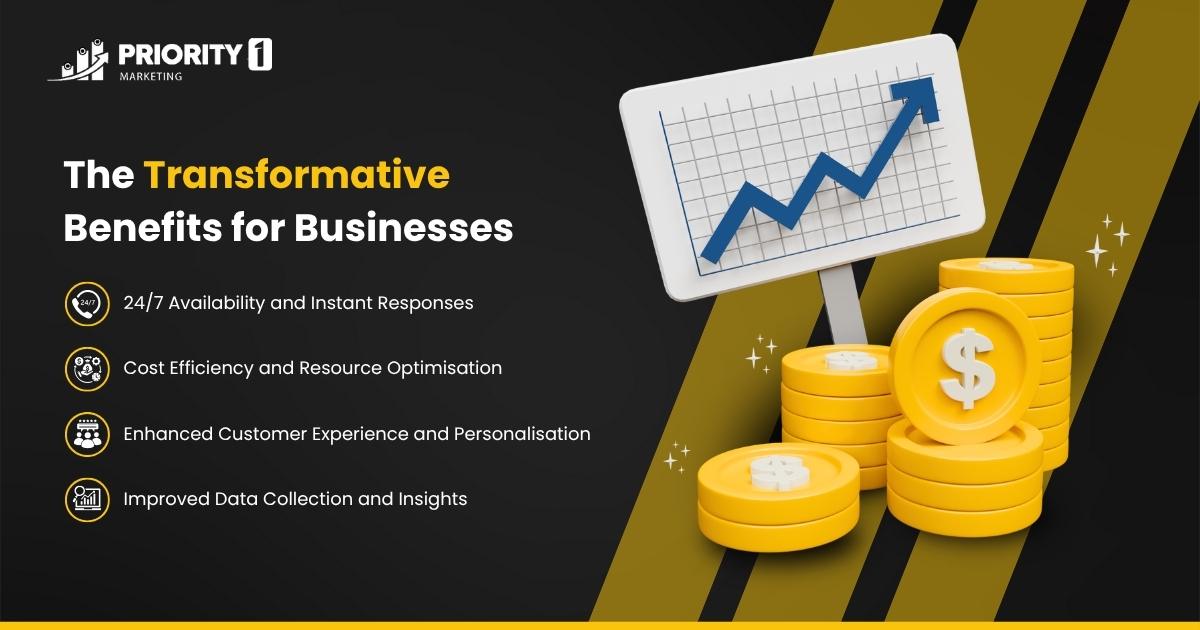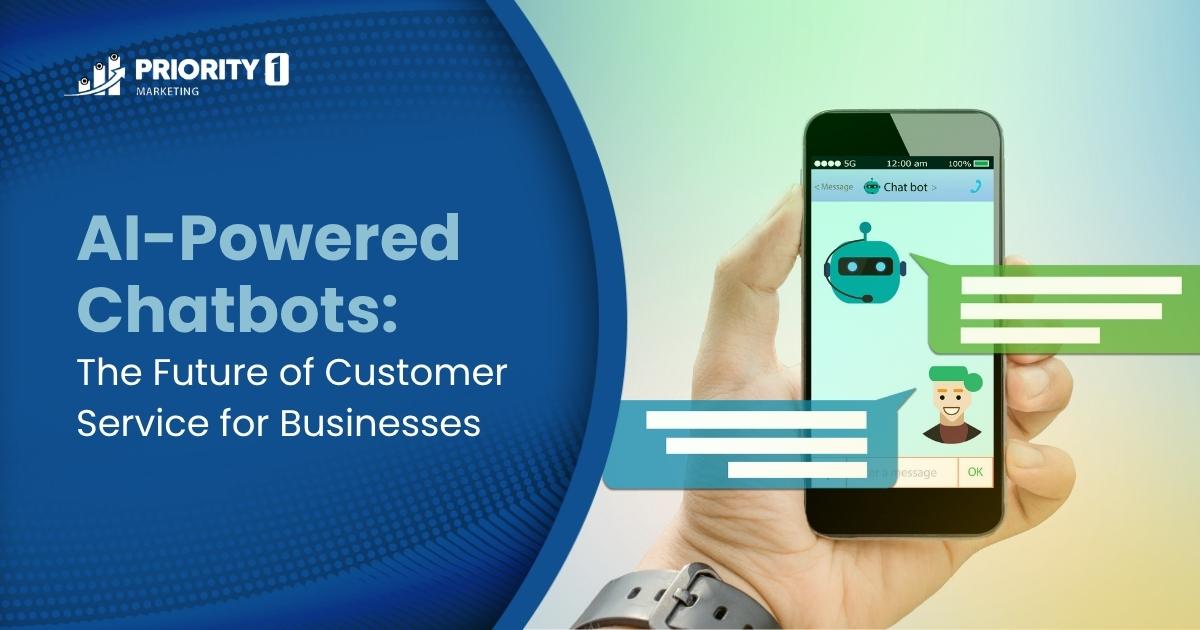
AI-Powered Chatbots: The Future of Customer Service for Businesses
Imagine this: you’ve been waiting on hold for over 20 minutes just to get a simple query answered. Frustrating, right? You’re not alone. Studies show that 62% of customers hang up after being placed on hold for more than one minute. In today’s fast-paced world, customers expect immediate, personalised support anytime, anywhere.
For businesses, meeting this expectation is becoming increasingly challenging. Traditional customer service models, with limited hours and human-dependent workflows, are struggling to keep pace.
Enter AI-powered chatbots, smart, scalable virtual assistants that are transforming customer service as we know it. These intelligent tools are no longer just an add-on; they’re becoming a necessity for businesses aiming to deliver instant, 24/7, and personalised customer experiences.
In this blog, Priority1 Marketing explores how AI chatbots work, their evolution, key benefits, essential features, how to implement them strategically, and what the future holds for customer service in the AI era.
Understanding AI-Powered Chatbots: Beyond the Basics
1. What Are AI-Powered Chatbots?
An AI-powered chatbot is a virtual assistant designed to simulate human-like conversations using Artificial Intelligence (AI), Machine Learning (ML), and Natural Language Processing (NLP). Unlike rule-based bots that respond to predefined keywords, these chatbots understand context, predict intent, and deliver meaningful, human-like conversations.
2. The Evolution: From Scripted Responses to Conversational AI
Gone are the days when chatbots could only respond to basic queries like “What are your hours?” Today’s AI chatbots use:
- NLP to engage in natural, flowing conversations.
- Machine Learning to improve responses over time based on user interactions.
- Sentiment Analysis to detect emotions like frustration or satisfaction and adjust accordingly.
This shift from static, keyword-driven bots to dynamic conversational AI has completely transformed how businesses interact with customers.
3. The Core Technologies Behind AI Chatbots
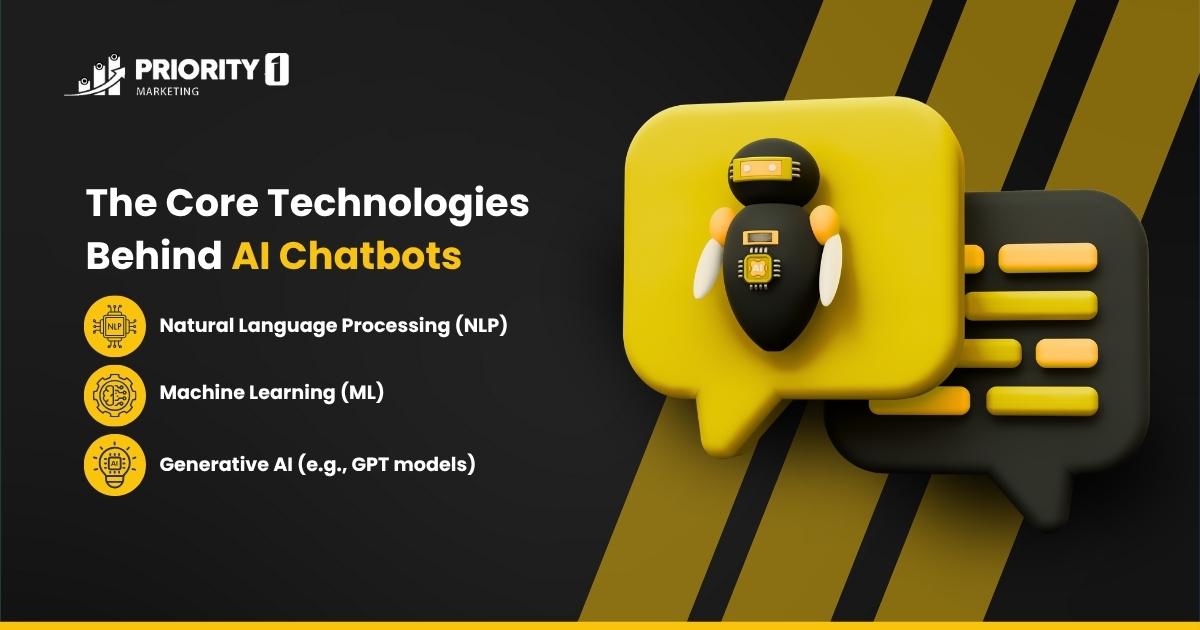
- Natural Language Processing (NLP): Helps chatbots understand language nuances, context, and sentiment.
- Machine Learning (ML): Allows chatbots to learn from conversations, continuously improving their accuracy and relevance.
- Generative AI (e.g., GPT models): Enables chatbots to produce creative, natural-sounding responses, handling complex conversations with ease.
The Transformative Benefits for Businesses
* 24/7 Availability and Instant Responses
Customers expect answers now, not later. AI-powered chatbots operate around the clock, eliminating wait times and providing real-time support, no matter the time zone. This boosts customer satisfaction and keeps businesses competitive globally.
* Cost Efficiency and Resource Optimisation
- Automate repetitive tasks like FAQs, booking appointments, or tracking orders.
- Reduce operational costs without compromising service quality.
- Free human agents to handle complex, emotional, or high-value interactions.
- Easily scale support during peak periods without hiring additional staff.
* Enhanced Customer Experience and Personalisation
- Personalised Support: By accessing CRM data, chatbots tailor responses based on customer history, preferences, or previous queries.
- Contextual Conversations: They remember past interactions, offering continuity and a smooth experience.
- Error Reduction: Customers receive accurate and consistent information, eliminating mistakes often caused by human error.
* Improved Data Collection and Insights
AI chatbots act as a goldmine for customer insights by tracking:
- Common queries
- Customer frustrations
- Buying patterns
- Feedback loops
This data can inform marketing strategies, product development, and service enhancements.
* Lead Generation and Sales Enablement
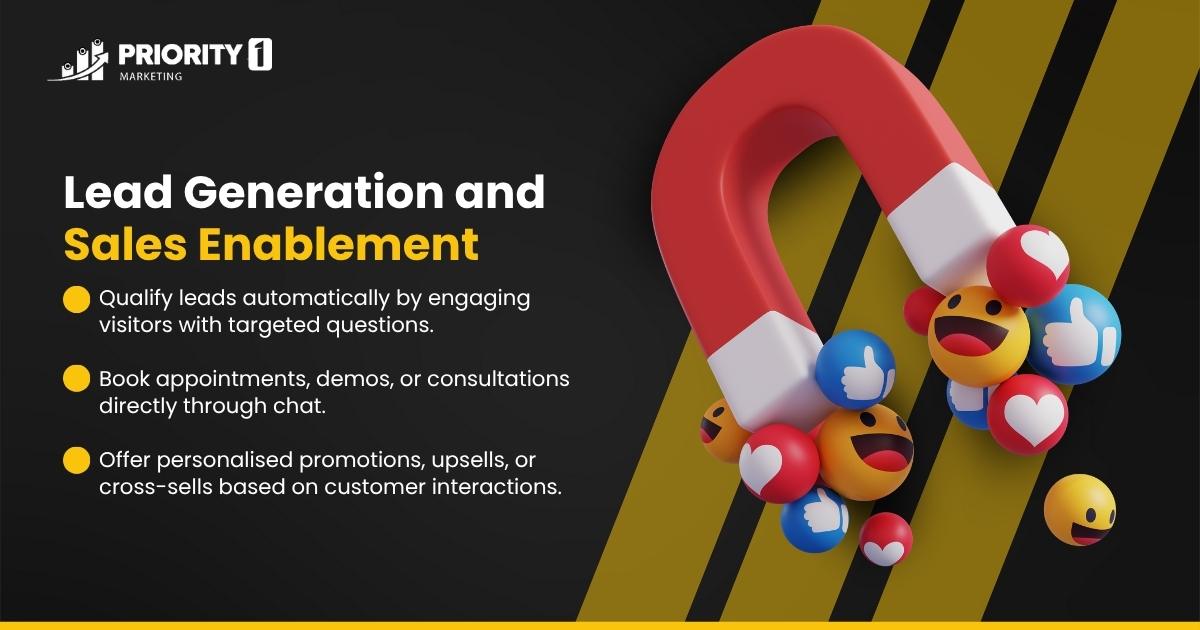
- Qualify leads automatically by engaging visitors with targeted questions.
- Book appointments, demos, or consultations directly through chat.
- Offer personalised promotions, upsells, or cross-sells based on customer interactions.
Example: A retail business implemented an AI chatbot and saw a 28% increase in qualified leads within three months, all automated.
Key Features of Next-Generation AI Chatbots

1. Advanced Natural Language Understanding (NLU)
- Understands complex phrasing, sarcasm, and slang.
- Supports multiple languages, enabling businesses to serve global audiences effortlessly.
2. Seamless Integration Capabilities
- Connects with CRM, ERP, and marketing automation tools.
- Delivers an omnichannel experience across websites, apps, social media, and messaging platforms.
3. Proactive Engagement and Predictive Capabilities
- Not just reactive—AI chatbots can offer assistance proactively based on a user’s behaviour, like spending time on a pricing page or abandoning a cart.
4. Human Handoff and Escalation
- For complex issues, chatbots seamlessly transfer conversations to human agents, retaining all context to ensure a smooth transition.
5. Real-Time Analytics and Reporting
- Measure resolution rates, average handling time, and customer satisfaction.
- Identify improvement areas to optimise the chatbot’s performance continually.
Use Cases of AI Chatbots: Real-World Applications Driving Business Success
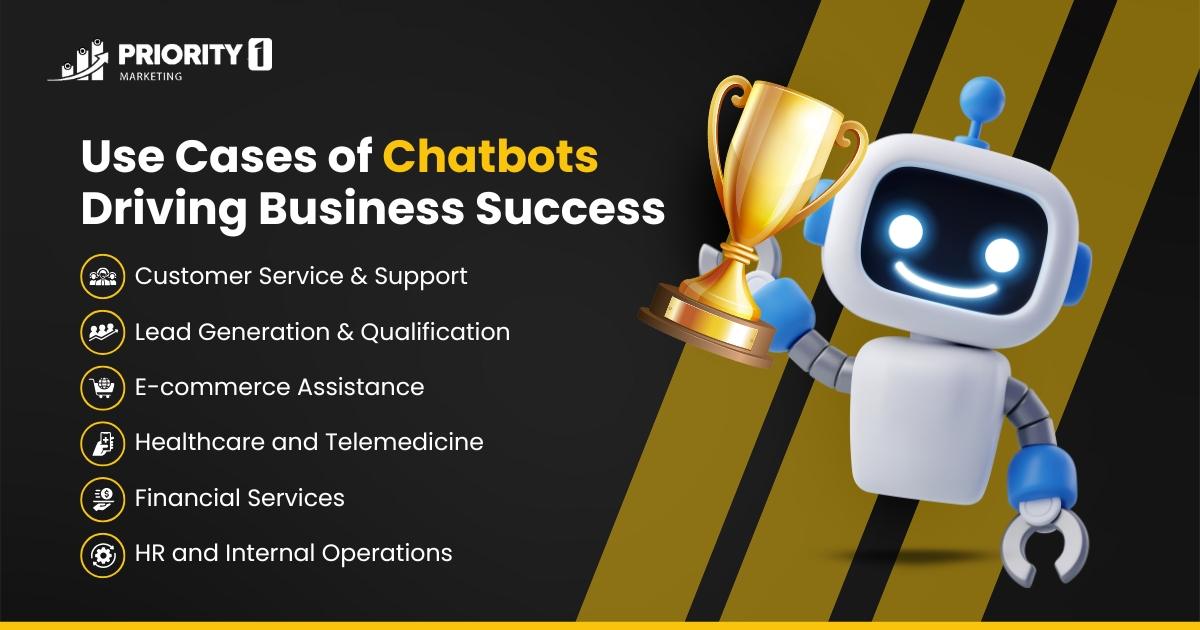
AI-powered chatbots are versatile tools, reshaping customer interactions across industries. Here’s how businesses leverage them beyond basic support:
A. Customer Service & Support
- 24/7 Query Resolution: Address common queries like order tracking, refund status, or appointment bookings anytime.
- Technical Support: Troubleshoot simple tech issues without human intervention.
B. Lead Generation & Qualification
- Interactive Lead Capture: Engage website visitors with tailored questions to capture contact details.
- Automated Qualification: Instantly qualify leads based on set criteria (budget, timeline, needs) and pass hot leads to the sales team.
C. E-commerce Assistance
- Product Recommendations: Chatbots suggest products based on browsing behaviour or purchase history.
- Cart Recovery: Trigger conversations when users abandon carts—offering help, discounts, or reminders to complete purchases.
D. Healthcare and Telemedicine
- Appointment Scheduling: Automate bookings, reschedules, and reminders.
- Symptom Checkers: Pre-screen patient symptoms before connecting them to healthcare professionals.
E. Financial Services
- Instant Account Information: Share balance updates, transaction details, or loan eligibility instantly.
- Fraud Detection Alerts: Notify customers proactively about suspicious activity.
F. HR and Internal Operations
- Employee Onboarding: Guide new hires through policies, documentation, and FAQs.
- IT Helpdesk Automation: Handle internal requests like password resets or system troubleshooting.
Example: A service provider reduced 70% of repetitive HR queries by implementing an internal chatbot.
Implementing AI-Powered Chatbots: A Strategic Approach
1. Define Clear Goals
Start by answering:
- What problems are we solving?
- Is the focus on reducing support tickets, improving lead capture, or both?
2. Choose the Right Technology
Select platforms that:
- Are scalable and secure.
- Integrate easily with your existing systems.
- Allow easy customisation based on your business needs.
3. Prioritise Training and Improvement
- Feed chatbots with FAQs, historical chat logs, and product data.
- Continuously monitor performance and refine based on customer interactions.
4. Balance Automation with the Human Touch
- While automation handles volume, ensure human agents are available for complex or sensitive cases.
Challenges of Implementing AI Chatbots: What Businesses Should Know
While AI-powered chatbots offer immense benefits, businesses must navigate some challenges for successful deployment.
* Data Quality and Training
- Garbage In, Garbage Out: If the chatbot is trained on outdated or incorrect information, its performance suffers.
- Continuous data refinement is essential to keep responses accurate and relevant.
* Understanding Complex Queries
- Despite advanced NLP, chatbots can struggle with:
- Sarcasm
- Highly technical questions
- Ambiguous phrasing
- Requires ongoing refinement and AI model tuning.
* User Resistance
- Some customers prefer human interaction over bots, especially for sensitive or emotional issues.
- Poor initial experiences can lead to frustration if the chatbot seems robotic or unhelpful.
* Integration Complexity
- Seamless chatbot performance demands integration with:
- CRM systems
- Payment gateways
- Inventory management
- Complex back-end integration can be time-consuming without expert support.
* Security and Compliance Risks
- Handling personal data requires strict adherence to data protection regulations like GDPR or Australia’s Privacy Act.
- Inadequate encryption or access controls could lead to data breaches.
* Cost vs. ROI Misalignment
- While AI chatbots reduce costs long-term, initial investment in setup, training, and integration may seem high.
- ROI depends on proper implementation, which is why choosing the right partner is crucial.
Solution: This is where Priority1 Marketing excels. Our team ensures end-to-end deployment—from platform selection and secure integration to training—making sure your chatbot delivers maximum value while avoiding common pitfalls.
The Future Outlook: What’s Next for AI in Customer Service?
- Hyper-Personalisation: Future bots will predict needs before the customer even articulates them.
- Voice AI: Seamless voice-to-text conversations with AI agents are on the rise.
- Emotional Intelligence: AI will become better at detecting tone and mood, delivering empathetic responses.
- Beyond Customer Service: AI chatbots will play a larger role in marketing, sales, HR onboarding, and internal communications.
Conclusion: Embrace the AI Revolution with Priority1 Marketing
AI-powered chatbots are no longer optional—they’re essential for businesses aiming to thrive in today’s customer-first digital landscape. Whether it’s handling thousands of customer queries, boosting lead generation, or streamlining internal operations, AI chatbots deliver real results.
Of course, like any technology, success depends on how well you implement it. With the right strategy and the right partner, your business can unlock the full potential of AI-driven customer service.
At Priority1 Marketing, we help businesses integrate tailored AI-powered chatbots that deliver on efficiency, engagement, and ROI.

